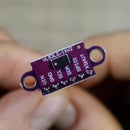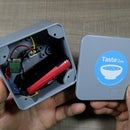Introduction: Xbox Series X Power Supply Repair
Hi everyone! In this Instructable, the focus is on a power supply from an Xbox Series X that unfortunately suffered damage due to a zero fault in the house, which caused an overvoltage situation. Not only did the Xbox get fried, but several other devices were also affected.
I've removed the power supply from the console, and now I'm going to show you how I carefully disassembled it from its metal casing and plastic enclosure to get to the heart of the problem. My initial suspect for the malfunction was the metal oxide varistor, which I anticipated might have burnt out due to the overvoltage, potentially along with the fuse, although I wasn't entirely sure about the latter at first.
I'll share with you every step of my diagnostic process and repair, including testing, desoldering, and replacing components. Whether you're facing a similar issue or are just curious about electronic repairs, this tutorial should offer some valuable insights. Let’s get started and see if we can bring this Xbox Series X power supply back to life!
This post is sponsored by PCBWay
PCBWay offers services for custom PCBs, PCBA, 3D printing, CNC machining, Injection molding, and more.
Check out their 2023 Christmas Big Sale to get access to discounts, lucky draws, tons of coupons, 50% OFF on selected items, blind boxes, and much more!
Supplies
- Xbox Series X Power Supply - https://s.click.aliexpress.com/e/_ok9Msm6
- Metal Oxide Varistors - https://s.click.aliexpress.com/e/_mM0VyEM
- PCB Fuses - https://s.click.aliexpress.com/e/_DdvkOav
- Multimeter - https://s.click.aliexpress.com/e/_mM0VyEM
- Torx Screwdriver - https://s.click.aliexpress.com/e/_mqyAVxS
- Soldering Rework Station - https://s.click.aliexpress.com/e/_EGbGGhj
Step 1: Disassembling the Power Supply and Removing the Heatsink Plate
After detaching the power supply from the Xbox, my next task was to remove it from its protective metal case. It took some maneuvering, but eventually, I was able to free it up. The power supply, which should output around 12 volts, wasn't giving out any voltage, confirming my initial suspicions of damage. I then proceeded to separate the electronics from the plastic housing that enveloped the circuitry within.
With the exterior casing out of the way, I could see the large capacitor just under the heatsink. Knowing these capacitors can retain charge, I carefully checked for any voltage. Fortunately, the capacitor had been discharged due to the time elapsed since the Xbox's failure. This allowed me to move on to unfastening and peeling away the glue securing the PCB to the bottom of the board without the risk of an electric shock.
The removal of the bottom heatsink plate was up next—a critical step since the heatsink draws away the heat generated by the power supply's diodes and integrated circuits. It was soldered to the ground plane at the corners, and to make the removal process smoother, I reapplied fresh solder to these joints while gently lifting the plate. Using a large-tip soldering iron helped, as the heatsink can absorb a lot of heat and make the removal challenging. A mixture of patience and persistent application of sufficient heat eventually allowed me to take off the plate, revealing the heat transfer material underneath—a silicon-like compound essential for effective thermal management.
Step 2: Visual Inspection and Testing for Short Circuits
Once I had all the components exposed, it was time for a thorough visual inspection. Visual checks can often reveal clear signs of damage, such as burn marks, melted components, or cracked parts. In this case, the metal oxide varistor was blown but I wanted to ensure no other components suffered collateral damage.
Next, I turned my attention to the diodes. Diodes are crucial for regulating the direction of current flow in the circuit, and a shorted diode can prevent the power supply from functioning correctly. To assess their condition, I carefully scraped off some of the remaining hard, white gluey substance obstructing my access to the component pins. Once I could reach them, I used my multimeter to test for continuity and to confirm that there were no short circuits present on the board. Ensuring diodes are functioning as intended is essential; a short can imply a failed component or a potential danger spot on the PCB.
During this investigation, I went component by component, double-checking that none of the ICs, which handle the power supply's switching, had any shorts. All the measurements came out positive, indicating that the rest of the board was intact and the problem was likely isolated to the areas I had already identified—the varistor and possibly the fuse. With the precise causes of the malfunction pinpointed, I could move on to replacing the damaged parts and work towards getting the Xbox's power supply operational again.
Step 3: Replacing the Varistor and the Fuse
Having identified the faulty components, it was time to replace them, starting with the varistor. The metal oxide varistor, or MOV for short, is designed to protect circuits against surges by clamping voltage to a safe level. Unsurprisingly, the surge that hit this Xbox was too much for the MOV to handle, and it was visibly damaged. The removal process began with applying fresh solder to the MOV's contacts, making it easier to desolder and remove without excessive force. Upon removing the outer sleeving, the extent of the damage was clear—a charred and cracked component was revealed.
Next came the fuse, which I initially overlooked. Fuses are the first line of defense against overcurrent, sacrificing themselves to save the rest of the circuit. After a more careful examination, I realized this fuse was indeed blown. I repeated the process implemented with the varistor—adding fresh solder for easier removal, and then gently pulling the fuse out while the solder was still molten on both pins.
For replacement parts, it is recommended that you purchase new replacement parts, but, I dug into my stash of salvaged components, searching for varistors and fuses with similar voltage and current ratings. When I came across suitable matches, I carefully soldered them into place. I started by fixing one leg at a time, ensuring proper alignment and fit into the PCB holes. I added a touch of fresh solder to secure the new components firmly, then inspected my work to make sure it was clean and stable.
With the new components in place, it was time to put the power supply to the test and see if our patient could be revived.
Step 4: Testing the Repaired Power Supply
With a new varistor and fuse installed, testing the power supply was the critical next step to ensure the repair was successful. To safely test electronics after a repair, I always use my dim bulb tester. This device allows me to introduce power to the circuit in a controlled manner, reducing the risk of damage if something's still amiss. The dim bulb tester acts as a current limiter, lighting up if there's an excessive current draw that could indicate a short or faulty repair.
I carefully connected the power supply to my dim bulb tester and powered it up. There was no dramatic change in the light bulb's intensity, the light bulb flashed a few times, indicating initial charging of capacitors but no sustained excessive current draw which was a good sign. I checked the power supply's output with my multimeter and to my relief, the correct voltage of close to 12V appeared on the screen.
I knew that the power supply was fixed, but before proceeding to handle it and return its enclosure, I had to ensure that the power supply was safe to handle. The large capacitor now held close to 380 volts—potentially dangerous if handled carelessly. To discharge the capacitor, I used a light bulb, connecting it across the capacitor's terminals. This safely drained the high voltage, reducing the risk of a nasty electric shock.
With the capacitor discharged and all electronic tests passed, it was time to put the hardware back together, ready for a final test within the Xbox console itself.
Step 5: Reassembly and Final Thoughts
After all the meticulous repairs and cautious testing, it was time to reverse the disassembly process and put everything back together. The reassembly of electronic devices like the Xbox Series X is quite systematic—if you took notes or have a good memory of the disassembly steps, the process is essentially those steps taken in reverse. I carefully realigned the repaired power supply within its plastic housing, trusting the built-in clips to secure it without needing additional glue. Following that, the metal case was reattached to provide its shielding and protection.
Throughout the reassembly, patience is key. I made sure to replace each screw and component methodically to avoid any mishaps. It's essential to handle all connectors with care, especially the delicate ribbon cables, to prevent any new issues from arising. Finally, I slipped the Wi-Fi card back into its slot, which I had momentarily forgotten during my initial reassembly, and secured the last few screws.
The final power-on was the true test, and to my satisfaction, the console powered up successfully, the account dashboard lighting up the screen.
I hope this guide has been helpful and perhaps even inspiring for your own electronics repairs. If you have any questions or need further clarification on this repair, feel free to leave a comment—I'm here to help. Remember, with the right tools and a bit of patience, most electronic repairs can be tackled at home. Good luck with your DIY projects, and I'll see you in the next tutorial. Cheers!
P.S. Feel free to check out my YouTube channel for more projects and repairs.













